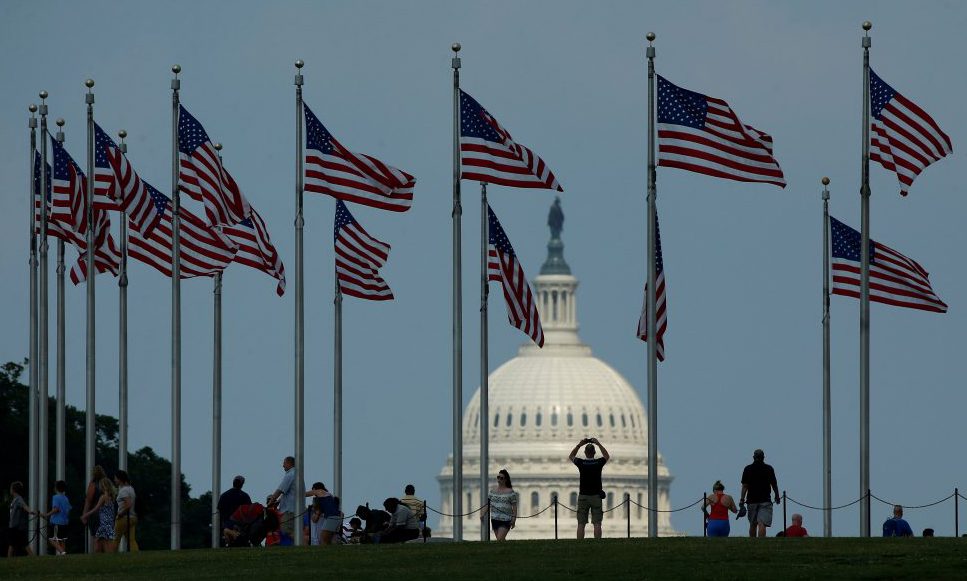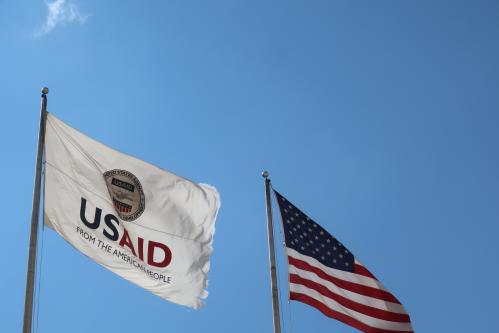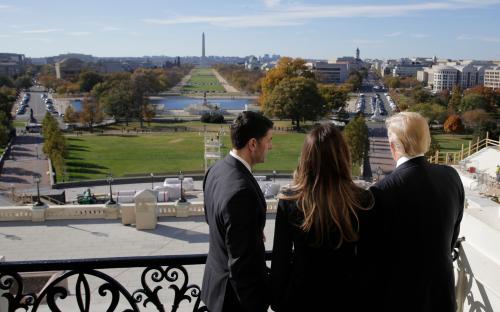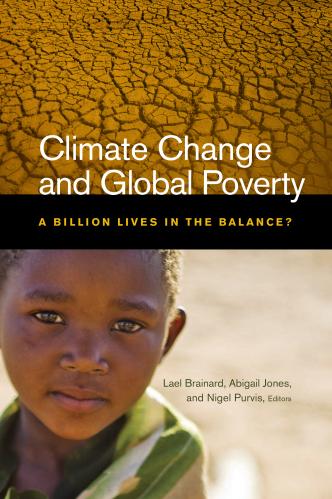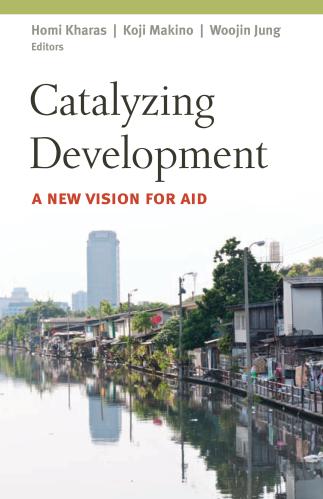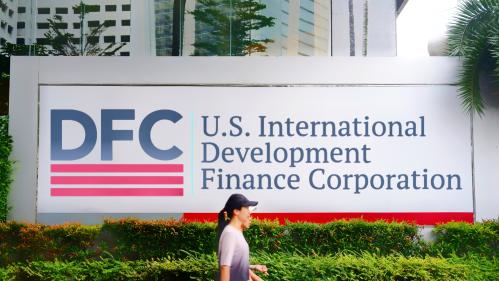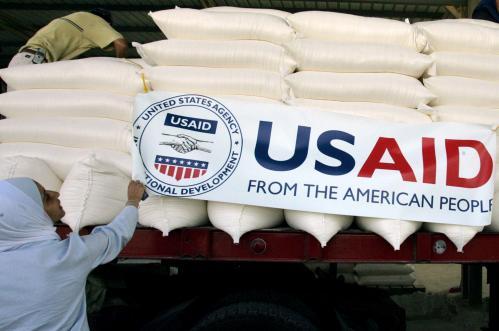From August 2-4, the Global Economy and Development Program at Brookings will host the 14th Annual Brookings Blum Roundtable, “U.S. Foreign Assistance Under Challenge.” The following is one of six briefs on topics to be highlighted at the roundtable.
“Bureaucratically fragmented, awkward, and slow, its (foreign aid) administration is diffused over a haphazard and irrational structure… The program is based on a series of legislative measures and administrative procedures conceived at different times and for different purposes and many of them obsolete, inconsistent, and unduly rigid and thus unsuited for our present needs and purpose.”—President John F. Kennedy’s Special Message to the Congress on Foreign Aid, March 22, 1961, that led to the enactment of the Foreign Assistance Act of 1961 and the establishment of United States Agency for International Development.
Status of administration agency reform plan
The Trump administration’s directive for agency restructuring and reported intent to merge USAID into the State Department have rekindled deliberations on how best to structure U.S. foreign assistance.
On March 13, 2017, the White House issued an executive order on a Comprehensive Plan for Reorganizing the executive branch. All agencies were directed to propose within 180 days a plan to improve efficiency, effectiveness, and accountability. Within a further 180 days, the director of the Office of Management and Budget (OMB) is to submit a plan to the president.
On April 12, the director of OMB issued a memorandum providing more detail on reforming the federal government and reducing the federal civilian workforce. By June 30, agencies were to submit to OMB a “high-level draft” and in the fall are to include the reform plan in their fiscal year 2019 budget submissions.
The director of OMB is to submit a government-wide reorganization plan in December, as part of the fiscal year 2019 budget.
As of mid-July the “high-level draft” the Department of State had submitted on behalf of itself and USAID to meet the June 30 deadline had not been made public. Insiders speculated that, whatever was submitted did not provide specifics on organizational restructuring.
USAID as an independent agency
A 1961 executive order issued by President Kennedy established USAID as an independent agency reporting to the president and the secretary of state. In 1979, President Jimmy Carter created through an executive order the International Development Cooperation Agency (ICDA), an umbrella organization comprised of agencies involved in foreign assistance. IDCA never had control over its component parts, and President Ronald Reagan designated Peter McPherson as both administrator of USAID and director of IDCA.
In 1998, legislation was enacted that abolished IDCA and by statute made USAID an independent agency reporting to the secretary of state.
USAID cannot be abolished or officially merged into the Department of State without legislation changing its statutory designation. According to one review, 21 statutes refer to the agency by name. Despite certain programs and authorities being assigned by statute to specific agencies, much of the authority to carry out foreign assistance is specifically designated to the president or the secretary of state, who can re-delegate the authorities to other government agencies and officers. Therefore, the president and the secretary of state have wide latitude in how they structure foreign assistance, as was demonstrated in 2006 when former Secretary of State Condoleezza Rice abolished the USAID offices responsible for policy, planning, and budget and transferred the functions and much of the staff to the new Office of U.S. Foreign Assistance Resources (F Bureau) in the Department of State.
In practice, outside of certain authorities designated by statute to a specific agency, actual authority and decisionmaking tend to depend on the will of the president and secretary and personal relationships.
Prior efforts at aid restructuring
The Foreign Assistance Act of 1961 and USAID were born out of frustration at the inefficiency of multiple government agencies carrying out foreign assistance. Depending on what one counts, to- day there are as many as 25 U.S. government agencies involved in the aid business running some 50 programs. The principal agencies are USAID; the Millennium Challenge Corporation (MCC); Departments of State, Treasury, Defense, Agriculture, and Health and Human Services (mainly through CDC); the Overseas Private Investment Corporation (OPIC); and the U.S. Trade and Development Authority (USTDA).
The two historic steps in 1961—the drafting of a new law and the creation of a single foreign assistance agency—were designed to bring coherence to U.S. assistance policies and structures. This effort proved to be a temporary fix.
The history of reviews and efforts to restructure U.S. foreign assistance is long and tortured. Since 1961 there have been 10 notable efforts to review or restructure U.S. foreign assistance, with the initiative shifting between the executive branch, Congress, and civil society.
- 1969 – A task force of private individuals appointed by the Nixon administration, known as the Peterson Commission, issued a series of recommendations in 1970.
- 1973 – Following the defeat of legislation to authorize foreign aid in 1971–1972, members of the House Committee on Foreign Affairs, supported by think tanks, drafted legislation to amend the Foreign Assistance The result was called New Directions, the law that spawned today’s “human-focused” and “sectoral” approaches to foreign assistance.
- 1979 – Senator Hubert Humphrey drafted legislation to bring all foreign assistance programs under a single umbrella agency. The legislation was not enacted, but President Carter implemented the idea by establishing the International Development Cooperation Agency.
- 1983 – President Reagan appointed the Carlucci Commission to review security and development assistance, in response to the perception that foreign aid was “broken” and unpopular in Congress.
- 1987 – The chairman of the House Committee on Foreign Affairs appointed the Hamilton- Gilman Task Force to review foreign assistance; the year-long review produced a report and led to a rewrite of the Foreign Assistance Act that was not enacted.
- 1993 – The Clinton administration commissioned an internal review of foreign assistance under the direction of Deputy Secretary of State Clifton Wharton. The review resulted in draft legislation to replace the Foreign Assistance Act but it was not enacted.
- 1997 – Following a two-three year struggle between Congress and the executive branch, President Clinton signed legislation that folded the U.S. Information Agency and U.S. Arms Control and Disarmament Agency into the Department of State and created USAID as an independent agency reporting to the secretary of state.
- 2006 – The Bush administration aimed to improve the coherence of foreign assistance by eliminating USAID’s offices of policy, planning, and budget and shifting those functions and much of the staff to the new State Department Office of U.S. Foreign Assistance Resources (F Bureau).
- 2006-2007 – The Helping to Enhance the Livelihood of People around the Globe (HELP) Commission, established by Congress to review U.S. foreign assistance and comprised of private citizens, issued a report and recommendations.
- 2009-2010 – Congressman Howard Berman orchestrated a two-year effort to write “The Global Partnerships Act of 2012” to replace the Foreign Assistance Act.
Recent aid reform plans
Atwood-Natsios
Former USAID administrators Brian Atwood and Andrew Natsios in December 2016 co-authored an article in Foreign Affairs, “Rethinking U.S. National Security: A New Role for International Development.” The context they paint is challenges to U.S. national security from state instability, terrorism and criminal groups, pandemics, and the pressures of population growth.
For development to play its role in the Three Ds—Development, Defense, and Diplomacy—as the first line of defense against transnational threats, and noting the distinct difference between the nature and requirements of development and diplomacy, they recommend the consolidation of all development functions in a new cabinet level department for international development.
The department would include all programs of relief and development (including refugee assistance), MCC, the President’s Emergency Plan For AIDS Relief (PEPFAR), the multilateral development banks, and U.N. agencies carrying out development and humanitarian programs. The department would issue a government-wide development strategy and review the initiatives of other cabinet departments. Economic Support Fund would remain under the domain of the Department of State.
The Heritage Foundation
Brett Schaefer of the Heritage Foundation published a paper in April 2016 titled “How to Make the State Department More Effective at Implementing U.S. Foreign Policy.” He notes various challenges to U.S. foreign policy and recommends a number of operational and structural changes for correcting internal State Department weaknesses.
The recommendations do not deal with foreign assistance or USAID, with one exception. He recommends merging USAID into the Department of State. The Bureau of Economic and Business Affairs would be renamed the Bureau for Economic Development headed by an undersecretary. The new bureau would encompass many of the responsibilities of the current bureau, all State Department programs related to development, USAID, and multilateral development banks. At the discretion of the next administration, it also could house the Office of the U.S. Trade Representative.
Modernizing Foreign Assistance Network
On June 9, 2017, the Modernizing Foreign Assistance Network (MFAN) issued a public sign-on set of principles as guidance for any structural reorganization of foreign assistance. It sets forth five structural requirements:
- An independent lead aid agency
- Strong policy, planning, and budget authority
- Accountable, transparent, and efficient functions
- Selectivity based on need and opportunity for assistance to be effective
- Sufficient resources
On July 11th the leadership of MFAN released an aid reorganization plan, “A New Foreign Aid Architecture Fit for Purpose,” which had been vetted within the MFAN community. The plan was issued as a discussion draft to catalyze ideas and a conversation on a new aid architecture. The plan would consolidate all development and relief functions into two new agencies: The Global Development Agency and the Development Finance Bank.
The Global Development Agency would encompass all development and relief activities—from the State Department, USAID, MCC, PEPFAR, and U.S. Department of Agriculture—headed by a director with cabinet status and a seat on the National Security Council. It would be structured according to goals and outcomes instead of regions and sectors—Relief & Resilience Center, Stability & Economic Growth Center, Millennium Challenge Center, and a Management Center. The only development functions left in their current bureaucratic structures would be the multilateral development banks and international organizations.
The Development Finance Bank would be an enhanced development finance institution. It would encompass OPIC and USTDA and have the expanded authorities of equity finance, guarantees, and first lost.
The Center for Strategic and International Studies
CSIS is scheduled to issue in late July a report from the bipartisan Congressional Task Force, comprised of former political and career USAID and State Department staff, reporting to Senators Todd Young and Jeanne Shaheen.
The final draft of the report begins with a set of principles to guide reform, including that development must remain a pillar of national security and foreign policy; development is a distinct discipline requiring distinct skills and approaches; and organizational efficiencies require clear lines of responsibilities and division of labor.
The principal recommendation is that USAID remain separate from the Department of State and the USAID administrator serve as the coordinator of foreign assistance. Programmatic functions would be transferred from the Department of State to USAID, and the agency’s functional bureaus would be revised into five bureaus—Economic Growth & Private Sector; PEPFAR/Global Health; Conflict & Fragility; Democracy, Rule of Law, and Governance; and Humanitarian Assistance. Independent agencies (MCC, OPIC, USTDA) would remain independent but report to the new coordinator to better align activities.
Other recommendations include moving the F Bureau and the State Department regional coordinating functions to USAID, closing missions that are no longer central to U.S. assistance strategy, and reforming the USAID personnel and procurement systems.
Center for Global Development
CGD is scheduled to publish in late July a paper on aid reform by Jeremy Konyndyk and Cindy Huang. An early July draft of the paper identifies four organizing pillars for U.S. assistance— global health, humanitarian assistance, state fragility, and economic growth.
The draft sets forth 11 structural recommendations that are characterized as “one-off reforms that could be implemented quickly.” They include aligning global health funding streams with agency capacities; consolidating USAID’s humanitarian assistance functions; fully implementing food aid reform with USDA no long involved; building a USAID surge capacity; improving USAID and MCC complementarity; and developing a full-fledged development finance institution by merging USTDA, USAID’s Development Credit Authority, and enterprise funds into OPIC and expanding OPIC’s authorities.
The paper also identifies for longer-term consideration three major structural alternatives—loosen central coordination (similar to an expanded F function), an empowered central coordination (similar to the Office of the Director of National Intelligence), and full consolidation of all development functions, including multilateral assistance and OPIC, into a new development agency.
Atlantic Council
The Atlantic Council is scheduled to issue a report focused principally on reform of the Department of State but also has a section on USAID. A near final draft of the report recommends maintaining USAID’s independence and position as the lead development agency. Other recommendations are to consolidate a critical mass of U.S. foreign assistance in USAID and to broaden its capabilities to implement a wider range of operational missions.
Common themes
The Trump administration’s “disruption” has energized the development and foreign policy communities to take a fresh look at how foreign assistance is structured. The overarching commonality y in the proposed plans is the consolidation of development and most foreign economic assistance in order to reduce redundancies and inefficiencies, achieve clear lines of authority, and establish mission alignment. This would allow both the Department of State and the development agency (USAID) to focus on their core mission and competencies. With one exception, the plans call for a clear distinction between development and diplomacy, with development directed and managed by a separate agency, but with close coordination between the Department of State. Several of the plans also emphasize the importance of the development agency having strong policy and budget capabilities and rigorous accountability and transparency.
The Brookings Institution is a nonprofit organization devoted to independent research and policy solutions. Its mission is to conduct high-quality, independent research and, based on that research, to provide innovative, practical recommendations for policymakers and the public. The conclusions and recommendations of any Brookings publication are solely those of its author(s), and do not reflect the views of the Institution, its management, or its other scholars.
Brookings gratefully acknowledges Richard C. Blum and the Rockefeller Foundation for their generous support of the 2017 Brookings Blum Roundtable.
Brookings recognizes that the value it provides is in its absolute commitment to quality, independence, and impact. Activities supported by its donors reflect this commitment.

